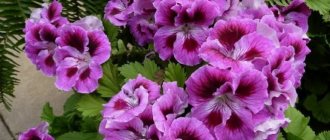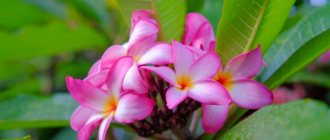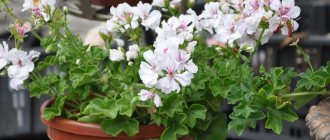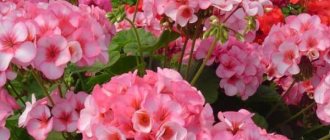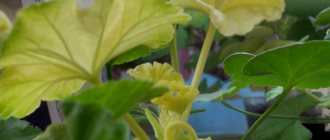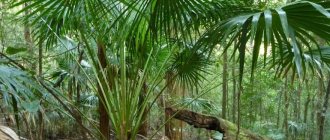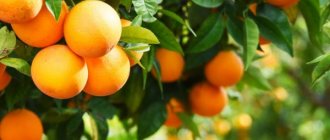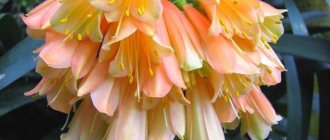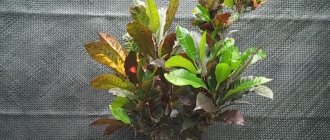Reproduction
It is carried out in two ways - seeds and cuttings.
The first option is considered the most difficult; it is almost impossible to obtain seed material on your own; they should be purchased from a reliable flower growing store. It is much easier to pick a cutting from the mother bush and root it. Sequence of actions: Carefully cut off 1-2 top shoots up to 8 cm long from the donor plant. Dip them in the growth stimulator "Epin"
Plant in nutritious soil, water carefully and cover with a plastic bottle to maintain temperature and humidity.
Ventilate the sprouts every day and moisten them if necessary.
Description of varieties
Among the varieties of pelargonium of the Elnaruds series, there are the most common ones.
Hilda
Compact pelargonium with lush double buds of uneven pink and white color. The leaves are yellow with a brown spot in the middle. Hilda tolerates heat well and has a long flowering period.
Gusten
A vigorously flowering variety of pelargonium Elnaryds. The inflorescences are dense, the buds are peachy-pink. The bush has a compact shape.
Bente
Zonal pelargonium. It reaches a height of 10 cm. The inflorescences are lush and double. The buds are apricot-red. Flowering of this species begins in May and continues until the end of September.
Bente flower
Otto is often used to decorate balconies and verandas. The buds of this variety are orange in color, gradually turning into soft pink. The bush reaches a height of 10 cm. Flowering begins in late spring.
A variety of flower called Otto
Singoalla
House plant with white, slightly pinkish flowers. The bush is compact and easy to shape.
Lilian
A dwarf plant with double voluminous inflorescences. The buds can be bluish-lavender in spring and pink in summer.
Representative of the Lilian variety
Clarissa
Lush bush with snow-white double flowers. The plant is compact and does not require formation.
Clarissa flower
Landing
Since the crop is mainly dwarf, the pots for planting should be purchased small so that the main emphasis during the growth of the plant is not on its root part, but on the shoot located above the ground. The land for planting should contain some sand and peat.
Seeds are planted in peat boxes. The seedlings should be kept in a room with an air temperature not exceeding +20 degrees Celsius. Typically, sprouts appear 21 days after planting. During the entire period, watering must be done by irrigation from a sprayer.
After planting the plant, it must be watered once every 2-3 days. The soil should not be too wet, but it should not be too dry.
The soil needs to be fertilized periodically. Flower shops sell formulations containing nitrogen, potassium and phosphorus. They should be fed to the plant during its growing season, but not more often than 2 times a month.
When a sufficient number of leaves and flowers have formed on the bushes, you can form a “cap” from the peduncle, pinch the leaves so that the bush grows in width and has an elegant, lush peduncle.
In summer, pelargonium should receive the maximum amount of fresh air for good growth. It is recommended to take it out onto balconies, terraces, into the garden under trees, in places protected from direct sunlight. The flower tolerates temperatures above +25 degrees Celsius reluctantly.
In winter, it is recommended to keep pelargonium bushes in cool rooms with a temperature not exceeding +13 degrees Celsius. At this time of year, you need to water the crop no more than twice a month.
To learn how to grow pelargonium, see the following video.
Keyboard input
There are alternative keyboard layouts that are optimized for entering typographic characters, including quotation marks (see, for example, Ilya Birman's typographic layout, official and unofficial versions of which are available for various operating systems). Most text editors, such as the proprietary Microsoft Office, the free OpenOffice and LibreOffice and many others, can be configured to automatically convert “simple quotes” into “Christmas trees” or “foot quotes”.
X Window System
In the X Window System (which is often used in UNIX-like operating systems, in particular those based on the Linux kernel), to type the French quote character, you must first press Compose, then twice < or twice >, depending on which side quotes should be facing.
Windows
In Windows, you need to enable Num Lock, after which typing on the numeric keypad works Alt+0171, Alt+0187 for « »
, and Alt+0132, Alt+0147 for
„ “
respectively.
To type the English double closing quotation mark ( ”
) use Alt+0148, for single (
' '
) use Alt+0145 and Alt+0146 respectively.
In some European layouts, entering Christmas trees is possible using the combinations AltGr+ and AltGr+ (American international), AltGr+z and AltGr+x (Canadian international).
Mac OS X
In the standard Russian layout of Mac OS X, quotes are typed using the following keyboard shortcuts:
| opening tree | ⌥ Option+⇧ Shift+= | |
| closing herringbone | ⌥Option+= | |
| opening foot | „ | ⌥Option+⇧Shift+ |
| closing tab | “ | ⌥Option+ |
Geranium pelargonium Elnaryds Hilda in Moscow
For sale is an adult, flowering plant in a pot of varietal pelargonium. Yellow leaf with a butterfly on a leaf. An example of flowering in the photo. Pickup. Call. There are other varieties, see, ask.
Columnia Lava Flow – Green leaves with a reddish tint at the base (
5 cm). Large red flowers with a bright yellow mesh pattern on the petals Photo 3-4 for sale young actively growing.
Moscow city – Indoor flowers and plants
Grows quickly, not picky
Moscow city – Indoor flowers and plants
Violet as a gift. Mature, strong, flowering plants are looking for new owners. If with a pot, then 100 rubles. Write a lot of plants.
Moscow city – Indoor flowers and plants
Little kids. 2 pcs
Moscow city – Indoor flowers and plants
I don't book. , call from 11 a.m. m Bibirevo Korneychuk St. Crassula hobbit - 50 RUR Decembrists pink 50 RUR, orange large 100 RUR and 20 RUR each, white all prices in the photo. m Bibirevo St. Korneychuk Pickup from home m.
Moscow city – Indoor flowers and plants
Rooted shoots of Hoya.
Moscow city – Indoor flowers and plants
Milkweed babies are waiting for you. The price for babies in cups is 50 rubles. In a pot is 150 rubles. in a plastic bucket with wick watering 100 rubles. .Please do not disturb advertisers.
Moscow city – Indoor flowers and plants
Photos 1-3 are an example of an adult plant. Photos 4-6 baby for sale.
Moscow city – Indoor flowers and plants
I will sell rooted cuttings of hoi: photo 1-2: EPC-600, one node one leaf - 200 rubles, one node two leaves - 250 rubles each, photo 3-10: Finlaysonii, leaves are hard, very large, contrasting veins, mother is blooming.
Moscow city – Indoor flowers and plants
Palm Utah, height more than two meters
Moscow city – Indoor flowers and plants
Elnaryds ebon pelargonium
All December orders will participate in the New Year's lottery. We will draw Yu Minuet and other prizes. More details in the note for the New Year's draw. After the 10th order, regular customer discounts of 10% apply. When additional discounts are offered. Then the discounts add up. You can track the number of orders yourself. There are no discounts on cuts. Instagram page @tasy_pelargon. Minimum order amount 1500 This already takes into account all discounts. Add 50 rubles for baggage inspection upon departure from the bus station. You can also email me Alison March 600 variegated Achevement 350 no Ainsdale Duke 350 cut 100 Aina 300 no cut 100 Annsbrook Sagitarius 400 cut 150 Annsbrook Mulbery Blotch 600 Amblush 350 Aland Lasse 350 cut 150 Alan Shellard 800 variegated no Alice Fergus 35 0 cut 150 Aldwick Cinnamon 250 no scented no Alex Kidson 400 no Anita 350 cut 100 April Snow 250 Automn 400 no Aunty Pat 400 Baby Rosebud 350 no Baby Brocade 350 Bills Dream 350 no Bo.
Method 1: Keyboard Input
English quotation marks on the keyboard are located on the key with the Russian letter “E”; they must be entered in the English layout.
In order to get “sticks”, you need to press the key combination “Shift+E”, and for single ones – only “E”. The first click adds an opening quote, the second - a closing quote. If characters are written before and after an already written word, their type will be determined automatically.
German paired quotation marks are entered in the same way as French ones - the familiar “herringbone” marks for us - by simultaneously pressing the “Shift+2” keys (in the upper numeric block).
Only this needs to be done not in the Russian, but in the German layout, so if there is none in the system, you will first need to add it through “Settings” or “Control Panel”, depending on the version of Windows.
There is another type of quotation marks, which, although visually not similar to commas (at least in most popular fonts), still belong to the “sticks”, which are the English and German ones discussed above. In order to enter them, you need to cancel the replacement with “Christmas trees”, which occurs automatically in Word.
Disabling auto-replacement of “stick” quotes with “herringbone” quotes Straight paired quotes, unlike the English and German ones discussed above, look the same, that is, there is no difference between the opening and closing quotes. If you want to use these symbols by default, you can disable their automatic replacement with Christmas trees. This is done in the “Options” of Word according to the following algorithm:
- Using the "File" menu on the top panel of the program, open its "Options".
Go to the “Spelling” section of the window that opens.
In the “AutoCorrect Options” option block, click on the button of the same name.
In the new window, go to the “AutoFormat as You Type” tab.
In the “Replace as you type” block, uncheck the “straight” quotes “paired” option and click “OK” for the changes to take effect.
From now on, quotation marks entered in the Russian-language layout in Word will look like paired “sticks” and will not be replaced with “Christmas trees”.
Description of pelargonium varieties of the Elnaryds series
Nothing is known about the origins of Elnaryds. However, the description of popular geranium varieties from this series is worth studying in order to choose the most suitable one for yourself.
Pelargonium Elnarids Hilda
Hilda
Pelargonium Elnaryds Hilda is a dwarf variety. The petals are white in the center, turning salmon color towards the edges. Double flowers.
Gusten
Pelargonium Elnaryds Gusten is distinguished by double inflorescences. The flowers are light peach in color. The bush is compact.
Bente
The Bente hybrid grows up to 10-12 cm in height. The inflorescences are double, the shade of the petals is soft apricot turning into a rich red color.
Lilian
The Lilian variety is characterized by lush inflorescences collected from double flowers. Petals are pale pink.
Clarissa
The Clarissa variety is distinguished by double and semi-double flowers collected in spherical inflorescences. Petals are white.
Variety Elnardis Clarissa
Reproduction
Pelargonium is propagated by cuttings or by planting seeds.
Cuttings
Pelargonium reproduces well by cuttings. This method preserves all varietal characteristics of the plant.
Cuttings can be harvested from early spring to autumn. Flowering time occurs after 16-20 weeks depending on the variety. It is not recommended to take cuttings from dormant plants (until the end of January).
For propagation, shoots 6-7 cm long with three leaves are prepared and the cut is air-dried for several hours. For dwarf varieties, cuttings 2.5-3 cm long are suitable. To do this, make a small cut at an acute angle, and remove the lower leaves. In order for pelargonium to take root well, you can use root-stimulating preparations, with which you need to lightly powder the cut and plant it in prepared pots.
There is no need to cover the cuttings. At a temperature of 20-22 degrees and regular watering, young pelargoniums will soon begin to grow. Typically, the rooting process takes from two weeks to a month, depending on the variety. When watering, you should try to prevent water from getting on the leaves and stem to avoid diseases. As soon as the cuttings begin to grow, they will need to be transplanted into separate pots with a special soil mixture recommended for pelargoniums.
For lush and branchy flowering, pinching above the fifth leaf is recommended.
Propagation by seeds
The recommended time for sowing seeds is the end of January - February. Some gardeners plant earlier. But in this case, additional lighting is required, since natural daylight hours are still too short, and the seedlings can become very elongated.
The seeds are sown in a container with moistened soil and sprinkled with a thin layer (approximately 2-3mm) of soil mixture. The optimal temperature for seedlings is 20-22 degrees.
Pelargonium seeds can also be sown in individual plastic or peat cups, 1-2 pieces each. In this case, picking is not required. The container with the seeds should be placed in a warm, bright place. Shoots appear in 5-10 days.
All this time you need to monitor the soil moisture and prevent it from drying out and forming a crust. It is better to moisten the soil by spraying. As soon as the seedlings appear, water carefully, trying not to get moisture on the leaves. After germination, the temperature can be slightly reduced to 18-20 degrees.
To prevent the seedlings from stretching, it is better to provide additional lighting. Phytolamps have proven themselves very well, thanks to which they produce strong, strong seedlings. Pinching above the fifth leaf is done in order to obtain a compact and lush pelargonium bush. For the same reason, it is recommended to pinch the flower every 2-3 months. If the seeds were sown in a common container, picking is done after the first true leaf appears.
When propagated by seeds, the flowering period begins after about six months.
Elnaryds pippi pelargonium
Prepared by Ekaterina Kotskaya based on the books: • Pelargonium (Royal Horticultural Society). Hazel Kay. 1993 • 1001 pelargonium. Hazel Kay. 2000 • Geraniums and pelargoniums. Jane Tylor. 1994
Pelargoniums first appeared in Europe around the middle of the 17th century. The parents of modern varieties (specific pelargoniums and their seeds) were brought to England and Holland on ships from South Africa. At first, it was mistakenly believed that India was the birthplace of pelargonium, and all because ships at that time were sailing from Europe to India. But on their way they made a stop at the Cape of Good Hope (the southernmost point of Africa), where the first pelargoniums were bought by sailors for European botanist collectors. It is the Cape Province of South Africa that is the birthplace of pelargoniums. About 80% of all pelargonium species known today were found here.
Pelargoniums are NOT GERANIUMS!
This is exactly how Hazel Kay, the owner of the famous English nursery Fibrex (the national collection of pelargoniums of England), writes emotionally in his book “1001 Pelargoniums”.
The name “geranium” was established back in the days when the science of botany was just beginning to classify plants. First, the Geranium family (Geraniaceae) appeared - winter-hardy and heat-loving plants, the common feature of which is a fruit similar to a bird’s beak, were included here under the same name “geranium”. Botanists then divided winter-hardy geraniums and heat-loving pelargoniums into separate genera - Geranium (geranium) and Pelargonium (pelargonium). And although a couple of centuries have passed since then*, the community of pelargonium lovers is with great difficulty and without much enthusiasm getting used to the correct long word “pelargonium” instead of the short and easy-to-remember “geranium”. We will probably agree that there is nothing terrible in using the name “geranium”, but only if secondly, after the scientifically literate PELARGONIA
.
So, who are pelargoniums from a scientific point of view? Pelargonium belongs to the geranium family (Geraniaceae), which includes five genera: Pelargonium - from the Greek Pelargos - stork. Geranium - from the Greek Geranos - crane. Erodium - from the Greek Erodius - heron. Monsonia - named after Lady Anne Monson, the granddaughter of the English King Charles II, who was fond of plants and had an active correspondence with the famous botanist Linnaeus. Sarcocaulon - from the Greek Sarcos and Caulon - fleshy stem.
Peculiarities
This flowering plant was first discovered on the African continent and in the southern regions of Asia. Later it began to be grown in different countries of the globe.
The culture is endowed with stems that can either creep along the ground or stand upright. The stems themselves are short, for this reason pelargonium is classified as a genus of dwarf plants.
The leaves come in a variety of shapes. They are:
- ordinary and feathery elements;
- leaves that are rough to the touch and look like fingers.
The flower stalks grow in the shape of a ball, they are very thick and lush. Pelargonium flowers are small, the petals are divided into double, simple, and come in a curved configuration. The plant contains a number of essential oils, due to which it is endowed with a bright citrus aroma. It has a fairly wide range of colors. The buds can be soft pink and have rich shades such as coral tones. Pelargonium is grown in pots, flowerpots, containers, cache-pots and other containers.
You can decorate your garden, terrace or balcony with pelargonium, provided that at the slightest drop in air temperature to +5.7 degrees Celsius, the flowers will be transferred to a warm room. Usually, pelargonium is planted in flowerpots outside. It does not withstand drafts and gusty winds.
Breeders have developed a large number of different varieties and hybrids of the plant. Pelargonium is divided into groups.
- Zonal. It includes up to hundreds of tall and dwarf bushes. Among decorative flowers, pelargonium Elnaryds Alexis is considered the most popular.
- Royal. It has a tall stem, with dense bushes with double and semi-double peduncles concentrated on it.
- The crop may be an ivy-leaved plant. It got its name from the peculiar shape of the leaves, similar to ivy, and the long stems flowing down the sides of the container in which the flower is planted. The inflorescences are lush and dense brushes.
- Pelargonium is also divided into succulent and fragrant crops.
The dwarf group includes several dozen pelargoniums, popular among gardeners. These include: Annelie, Hilda, Otto, Bente, Gusten, Lilian, Olivia, Ebon, Ljuvliga, Julia, Jazz, Alizia, Pippi, Rasken, Clarissa, Lina, Lady Molly, Windcatcher, Maestro, One of a Kind and many other names.
Pelargonium Elnaryds Alexis has proven itself well. This is a dwarf bush with bright green leaves and white flowers interspersed with pink. The shape of the flowers is very beautiful, they look like lace. This pelargonium blooms early and pleases the eye for a long time with its abundant flower stalks.
Many indoor plant lovers grow Annelie pelargonium at home. This is a bush with white and pink wavy and double buds. The flowers are medium in shape and the leaves are dark in color. It begins to bloom very early, in late May or early June.
The Hilda variety is very popular among gardeners. Dwarf bush with dark leaves. Its peduncles are dense and have a double shade. The white tone towards the center of the flower smoothly turns into salmon color. The buds are terry and rich in structure.
Otto pelargonium is planted in flowerpots to decorate gazebos or terraces. It is endowed with double orange flowers turning into a salmon tone. During the growth process, large flower caps are formed. The plant reaches 8-10 cm in height. Blooms all summer starting in May.
Elnaryds Bente is a relatively new flower, recently bred by Swedish breeders. It belongs to the type of zonal pelargonium. It rises in height by 8-10 cm. The inflorescences are very beautiful, double and lush in the middle. Most often they are a delicate apricot color, turning into a rich shade similar to red sand. Pelargonium blooms in May.
Unusual pelargonium, or common geranium. Garden planting and care
Pelargonium, more commonly known to you as geranium, grows in pots for many people, but few people know that plants of this family are also suitable for open ground. Pelargonium, due to its medicinal and aesthetic qualities, is loved not only by many gardeners, but also by people involved in landscape design. Therefore, I propose to take a closer look at this beautiful flower.
Pelargonium can be grown not only in pots, but also in open ground
Pelargonium, which came to us from southern Africa, is perhaps the most common potted plant. However, it successfully took root not only on the window, but also in the garden. With good care, pelargonium blooms all summer. Increasingly, the eyes of landscape designers are turning towards this flower, and there are several reasons for this: the possibility of planting in forms, relatively simple care and a bright addition to any flower arrangement.
Pelargonium belongs to the Geranium family and can be a subshrub or herbaceous plant. Cultivated as a perennial. Its flowers are varied in color, collected in umbrellas or shields. Some varieties are distinguished by huge round terry “caps” of flowers. Pelargonium comes with straight, branched or creeping stems; it has very beautiful, decorative leaves.
Pelargoniums are very diverse in flower color and bush height
Planting pelargonium
Despite the fact that pelargonium is a perennial plant, it freezes in winter in the middle zone, so there are subtleties in its cultivation.
In order for pelargonium to bloom all summer, it needs to create appropriate conditions. Choose soil with a slightly acidic or neutral reaction; its composition must be light; the presence of peat and river sand has a beneficial effect on the plant. In the fall, when you dig up the soil, add humus and mineral fertilizers.
Pelargonium can grow in the garden, but it is better for it to winter at home
Pelargonium takes well to watering, so you need to water it moderately and not allow the soil to dry out. Although it can tolerate drought normally.
But it’s better not to plant it in open sun either: the optimal temperature for growth and development of pelargonium is +15°C, so the semi-sunny side is considered the best, or it will still have to be shaded.
Depending on the species, pelargonium has a number of individual characteristics, but the principles of planting and care are largely the same. To root green cuttings in the garden, you need to plant them in a mixture of peat and river sand. But you can also root at home using perlite.
Pelargonium care
Rest period
Once in the garden, pelargonium blooms all summer. But like any living organism, it gets tired, so until spring, give the plant a rest for about 1.5-2 months, put it into a dormant state. To do this, do not water pelargonium or feed it with mineral fertilizers. By spring it will wake up and bloom again. There are many opinions regarding the wintering of pelargonium. But I wouldn’t risk leaving it in the garden: for the winter, the bush must be transplanted into a pot and taken home.
Pelargonium should not be left in the garden for the winter. Replant it in a pot and take it home
Fertilizers
During the period of active pelargonium, use complex fertilizers for flowering plants.
Trimming
In the spring, so that pelargonium actively begins to grow and delights with abundant lush flowering, the tops of the shoots can be pinched. But the tops do not have to be thrown away; they can be rooted and new plants can be obtained.
The tops of the shoots need to be pinched so that the bush is lush next year
Pelargonium propagation
Pelargonium propagates by seeds and vegetatively (green cuttings).
- Many hobbyists root cuttings directly in winter; to do this, plant the cuttings in sand or perlite and moisten them. Cuttings are taken from mother plants overwintering at home at a temperature not exceeding +12°C. Cuttings are rooted in January at +16°C; already at this temperature the plant begins to take root. Next, the temperature is increased to +20°C, the formation of a full-fledged root system of the cutting occurs in about 3 weeks. When the root system is formed, transplant the young plants into small pots and take them to the greenhouse for hardening and growing. It can also be grown on a window.
Pelargonium cuttings are usually rooted in perlite, but they root well just in water
- Seeds should also be sown in containers in winter, from December to February, the soil mixture should consist of river sand and peat or peat alone. You will have to wait about 3 weeks for germination, during which time the soil must be regularly moistened. It is advisable to cover the top of the container with film. When the seedlings reach the stage of three true leaves, they are planted in separate containers. To make the plant more bushy, pinch it above the 6th leaf.
Types of pelargonium
The pelargonium genus has about 250 species that grow in South Africa. In our country, the most common ones, which have given rise to many varieties and hybrids, are the zonal plant and the ivy leaf plant.
Our market will help you choose pelargonium seeds and seedlings - an illustrated catalog of products from various online stores.
Pelargonium zonale
The contoured, patterned leaves of this perennial pelargonium can be light or dark green. A number of well-known sources say that this species is annual, but I would say that it simply does not overwinter in open ground. I dig it up and replant it in a pot, so even in winter my pelargonium blooms.
Pelargonium zonal
In winter, queen cells are stored at temperatures up to +23°C. When the plant fades, the shoots are cut to 10 cm and the container is moved to a bright, cool room with a temperature no higher than +15°C. By the way, this species tolerates drought well and has many new interesting varieties and hybrids. Bright colors (white, red, dark red, crimson, pink) and spherical umbrella-shaped inflorescences with simple or double flowers are why gardeners love this pelargonium so much. Zonal pelargonium can decorate not only a window sill, but also hanging baskets, tubs and containers, flower beds, borders or borders.
Pelargonium of this species does not tolerate excess moisture, can withstand temperatures down to -6°C, and at temperatures below +9°C the leaves turn yellow. Varieties and hybrids affect the height of the plant: for example, the 'Meteor' is short, so it is used for borders. And in the 'Rocky Mountain' you can find vigorous-growing varieties, and also in unusual shades. Medium-sized unusual varieties
- 'Rumba Fire' - fiery, I would say, bordering on the "poisonous" saturation of the red color, attracts attention from any point of view.
Pelargonium zonal
- 'Bravo Pastel' - petals are white, gradually turning into pink, with a delicate crimson eye
Pelargonium zonalis 'Bravo Pastel'
Description of varieties
Among the varieties of pelargonium of the Elnaruds series, there are the most common ones.
Hilda
Compact pelargonium with lush double buds of uneven pink and white color. The leaves are yellow with a brown spot in the middle. Hilda tolerates heat well and has a long flowering period.
Gusten
A vigorously flowering variety of pelargonium Elnaryds. The inflorescences are dense, the buds are peachy-pink. The bush has a compact shape.
Variety Gusten
Bente
Zonal pelargonium. It reaches a height of 10 cm. The inflorescences are lush and double. The buds are apricot-red. Flowering of this species begins in May and continues until the end of September.
Bente flower
Otto
Otto is often used to decorate balconies and verandas. The buds of this variety are orange in color, gradually turning into soft pink. The bush reaches a height of 10 cm. Flowering begins in late spring.
A variety of flower called Otto
Singoalla
House plant with white, slightly pinkish flowers. The bush is compact and easy to shape.
Pelargonium Singoalla
Lilian
A dwarf plant with double voluminous inflorescences. The buds can be bluish-lavender in spring and pink in summer.
Representative of the Lilian variety
Clarissa
Lush bush with snow-white double flowers. The plant is compact and does not require formation.
Clarissa flower
Description of tulip pelargonium
After reading the description of tulip-shaped pelargonium, it is difficult to say that there are still significant points that distinguish it from other varieties. Such plants can also be either large or dwarf. Growth varies between 30 and 80 cm. The leaf blades are hard with a glossy sheen characteristic of the group. Until the plant blooms, it is difficult to determine what kind of geranium it is. This can only be done during the flowering period.
The flowers of tulip-flowered pelargonium are semi-closed, as shown in the photo of the varieties below. The bud consists of 6-9 corolla petals. They can be simple or terry. The edge of the petal is smooth or crenate. The diameter of the flower reaches approximately 1 cm or less. I will emphasize the depth of the bud. The core is several shades darker, which makes the flower seem three-dimensional.
The inflorescence can contain up to 40 half-opened buds of pink or burgundy color. The outer part of the petals has clear veins, which gives the bouquet even more decor. Some gardeners and florists use the tulip-shaped variety to create bouquets. However, when cut, the inflorescence quickly loses its neatness and fades.
Pelargonium Elnaryds: description and cultivation
Among the variety of ornamental geranium plants, pelargonium occupies a leading place. It is loved by many gardeners for its short stature, curly and lush bushes, abundantly dotted with buds, as well as for its long flowering period. This herbaceous crop will be discussed in the article.
Plant care
In order for pelargonium to bloom profusely and not get sick, it needs to be looked after regularly.
- Watering should be regular and moderate. It is advisable to use water that has stood for two days.
- During the growing season, fertilizing is applied to the soil. Mineral fertilizers are suitable for flowering crops. Wood ash is used from organic matter.
- Organize proper lighting. The flower prefers diffused light. It is recommended to place pots on western windows.
- After flowering, the inflorescences are cut off. You also need to immediately pick off dry and yellowed leaves.
Overall, geraniums are easy to care for.
The plant needs to be watered regularly
Planting a flower
The optimal time to plant a plant is spring, when the growing season has just begun. Before planting in the soil, you must add complex mineral fertilizers.
Pelargonium Knight Salmon - description of varieties of the Salmon series
Planting process:
- Fill the bottom of the pot with drainage, then some soil.
- Place the plant in a pot.
- Fill with the second part of the soil.
- Compact the soil and then add some more soil.
Planting ends with abundant watering of the flower with warm water that has been standing for two days.
Important! The soil should be neutral or slightly acidic.
Pelargoniums from seeds
of hybrid zonal pelargoniums in stores.
— hybrids (First generation) of the first generation (F1) and second generation (F2), from which compact, unpretentious plants grow, blooming profusely.
Pelargonium “Magic of Summer F2”, seeds of a mixture of colors.
Depending on the size of the bush and inflorescence, pelargoniums grown from seeds are divided into two groups:
- multiflora - with low, compact and abundantly flowering bushes, resistant to rain and wind, grows well in balcony and window boxes, in garden flowerpots and flower beds
- grandiflora - taller bushes, bloom less profusely, but have very large flowers and inflorescences, ideal for bouquets
You can plant seeds in December, January or early February. Then they will bloom in the year of planting.
Diseases and pests
Pelargonium has high immunity, so pests and diseases rarely bother it. But if not properly cared for, problems can still arise.
Blooming Pelargonium Hilda
If the plant is in the wrong place or has an incorrect watering schedule, this is indicated by the following signs:
- lack of flowering;
- rusty or dried leaves;
- rotting of the root system.
It is necessary to immediately eliminate the cause of the disease and treat the plant with fungicides.
In some cases, aphids, mealybugs or whiteflies may appear on the bush. When they are detected, the flower is sprayed with insecticides.
With proper care, pelargonium will become an excellent ornamental plant with bright, unusual flowers.
Pelargonium and geranium - similarities and differences
Both plants belong to the same Geranium family. The family includes 5 genera and 800 species of other plants. Geranium belongs to the most numerous genus, and pelargonium is the most popular. One of the signs by which Carl Linnaeus united them was the similarity of the fruit capsule. After fertilization, the elongated pistil slightly resembles the beak of a crane, which explains the name of the plants. Translated from Greek, "Pelargos" means stork, and "Geranium" means crane.
Both pelargonium and geranium have erect stems with alternately growing leaves. The next similarity is that both plants have slightly pubescent leaves (covered with small hairs). Also, many geraniums have a special aroma.
Both pelargonium and geranium are easy to propagate and are considered unpretentious plants.
The differences are visible, perhaps, only to specialists. Geranium and pelargonium cannot be crossed. You just won't get any seeds. This is due to differences in genetic characteristics.
South Africa is considered the birthplace of pelargonium. The birthplace of geranium is the Northern Hemisphere. That is why southern pelargonium can only overwinter indoors, while geranium is more cold-resistant and can bloom even at 12 degrees Celsius.
In summer, pelargonium often decorates flower beds, verandas and balconies. But with the onset of winter, it must be put away in a warm room.
Geranium feels comfortable in gardens and even survives wintering, with the exception of the most northern regions. Therefore, it is common to consider geranium as a garden plant, and pelargonium as an indoor plant.
There are also external signs by which geranium and pelargonium can be distinguished.
- Geranium flowers consist of 5 or 8 petals. Typically, these are single flowers, which are occasionally collected in inflorescences. In domestic pelargonium, the corolla of the flower has an irregular shape, namely the two upper petals are slightly larger, the three lower petals are smaller. Pelargonium flowers are grouped into large inflorescences resembling umbrellas.
- Geranium, among the huge variety of its shades, does not have scarlet. Pelargonium does not have blue flowers.
This is interesting: The subtleties of installing a fireplace
The history of the appearance of the pelargonium variety Elnarids
Pelargonium was first discovered in the wild in Africa and southern Asia. Then it quickly spread across all continents, and came to Europe in the 17th century. Later, thanks to the efforts of breeders, different types of flowers were bred. Many of them began to be grown as ornamental plants.
This is interesting! Pelargonium and geranium are often confused. You can distinguish them by their bud. Geranium has 5 identical petals. Pelargonium has 2 upper and 3 lower ones, differing from each other in size and shape.
Caring for ampelous pelargonium
How to care for ampelous pelargonium
Pelargonium is light-loving, and (which is a rare advantage) tolerates direct sunlight well. It stoically tolerates dry soil and air, but dies when overmoistened, so it needs good drainage. Pelargonium is not afraid of severe cold, but it dies from light frost. Pelargonium does not need to spray the leaves; moreover, it is contraindicated for it, because rot will appear on the leaves, and this will lead to serious diseases.
Fertilizer of ampelous pelargonium
Ivy pelargonium should be fed weekly during the flowering period (from March to August) with low-concentration complex mineral fertilizer. She also likes to drink milk diluted with water. The soil for geraniums needs loamy, light, fertile, high potassium content, but low nitrogen content: with its excess, the leaves of indoor geraniums become larger, but flowering slows down. The soil mixture should be approximately this: two parts each of turf soil, lowland peat and leaf soil and one part sand.
Transplanting ampelous pelargonium
Ampelous geraniums need to be replanted once every two years in the spring into a tight pot (the roots should be located close to the walls). If the old pot is still old enough for the plant, replace only the top layer of soil.
Reproduction of ampelous pelargonium
Pelargonium can be grown from seeds, but there are too many nuances to consider. Only experienced gardeners can do this, but they also prefer to propagate pelargonium by cuttings. Cuttings that have been pre-dried for 24 hours (the cuts must be dry) are dipped in charcoal powder and planted in disinfected (with boiling water or in the oven) soil at a distance of 2 cm from each other, compacting the soil on all sides with your fingers. It takes a month for the cuttings to take root, and if the planting took place in the spring, then in the summer your cutting may bloom.
Rules for growing pelargonium Swanland Pink/Australien Pink Rosebud
Swanland Pink needs conditions typical for zonal pelargoniums, that is, good lighting and warm content, a nutritious, but at the same time loose, permeable substrate.
Thus, growing Australien Pink Rosebud pelargonium comes down to several points:
- Lighting. It is preferable to have well-lit window sills that are exposed to the sun for several hours a day. On the south side, it is advisable to shade the pots so that the leaves do not suffer from burns; it is better not to grow them on northern windows;
- Watering . It is necessary to moisten the soil constantly, as the top layer of the substrate dries, but always in moderation. The earthen lump should neither dry out nor become waterlogged;
- Trimming . To obtain a compact bush with a harmonious crown, pelargonium must be pruned. Strong shortening of shoots is carried out at the end of February, sanitary pruning is carried out as necessary. Pinching the apical and lateral cuttings is also required;
- Feeding . During the period of bud formation and flowering, Australian Pink Rosebud must be fed using fertilizers for Geraniums or compositions for flowering indoor plants.
